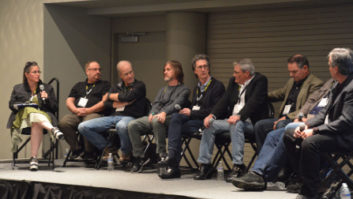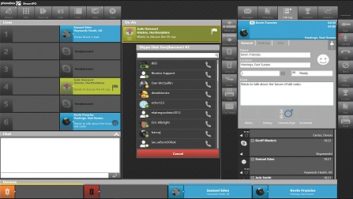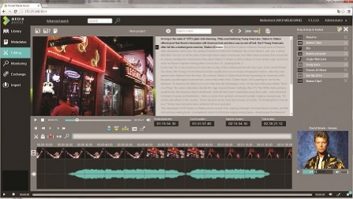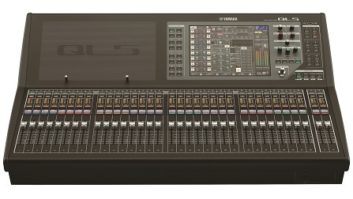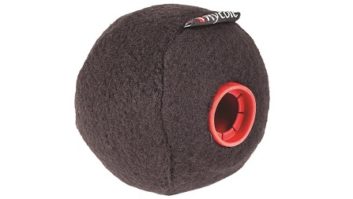Ten years ago New York was a different place. Reeling from the attacks on the World Trade Center, the city had pressed the Jacob K. Javits Convention Center and other large venues into use for triage. This meant postponing the AES convention until late November 2001.
In 2011, as the new Trade Center rises towards unprecedented heights, New York again feels optimistic and vibrant. As it does in alternating years, the Audio Engineering Society reconvened in October for the 131st AES Convention in the Javits Center to enthusiastic crowds, though now relocated from its more familiar space in the South Concourse to the North end of the main center.

The Studer OnAir 1500 is a six-fader control surface with integral jingle player and USB audio storage.
The gear
Products drew conventioneers to the 310-booth exhibit floor. While many folks wondered why players such as Adobe (Audition DAW software), Loud Technologies (Mackie) and Sony didn’t make the trip, there was plenty to keep the 16,000 or so visitors occupied.
From the start, it was hard to miss the Avid exhibit. The company rolled out version 10 of its industry standard Pro Tools workstation. The new version boasts Clip Gain, allowing individual clips recorded at different times and settings to all start out at the same level. Pro Tools is available as software only for the Mac and Windows, or in the HDX configuration with dedicated cards handling up to 256 audio tracks per card.
Only a few other workstation manufacturers peppered the exhibit floor, including Samplitude Pro-X from Magix, the veteran Pyramix from Merging Technologies and Harrison’s MixBus, easily the best bargain on the floor at $150, with the tonality of a Harrison console mated with an open-source audio engine. Many mixers on display were primarily for music recording and complicated commercial mixing, but a number of manufacturers were happy to show off radio broadcast-style consoles.
The Studer entry was the diminutive OnAir 1500, a six-fader control surface intended to work with the company’s Nano Score engine. Among the surprises under the hood, an integral jingle player with USB audio storage, VoIP telephone connectivity and 12 assignable soft keys to implement any function desired by the on-air operator.

Harrison MixBus
Lawo AG of Germany exhibited its Sapphire broadcast console line, with DSP on each channel, a detailed meter overbridge, VisTool touchscreen interface and full connectivity to the company’s DALLIS I/O engine.
Intended more for television but suitable for radio program production, the Solid State Logic C10 mixer includes onboard spot and music playout and up to 512 audio paths. One product more relevant to basic radio production might be the company’s Nucleus workstation controller, compatible with Pro Tools, Nuendo and other DAW environments.
Mixing microphones in the field? Head out there with a Sound Devices MixPre-D portable mixer, with mic/line-switchable balanced XLRs, a dedicated consumer mic-level input on a locking TA3 connector and an aux level output on a 3.5 mm connection. The MixPre-D has XLR and USB digital outputs to jack directly into a DAW computer or laptop running Mac, Windows or Linux.
Sound Devices also had the Mix Assist software for its model 788T eight-input, 12-track digital audio recorder. While better suited for location audio recording for TV and film production, the primary feature of Mix Assist is that it turns down unused microphones while instantly activating only the microphones that are in use. For multi-mic setups in the field, Mix Assist assures a clean recording.
On the topic of remote recording, Yamaha stepped up with the Pocketrak W24 handheld recorder, capable of up to 108 hours of MP3 audio on a 16 GB SD card; Sony, courtesy of Shoreview Distribution, showed the PCM-D50 handheld stereo recorder, with a pair of flexible built-in X-Y mics and TASCAM exhibited the affordable (under $100 street) DR-05 pocket recorder and the portable 8-track DP-008 unit for in-field multitrack recording.
Veteran radio newshounds would well have mourned the absence of on-the-go cassette and MiniDisc recorders. It truly was a new world on that exhibit floor.

Capstan from Celemony removes wow and flutter from tape and vinyl recordings made on questionable gear.
Tech, tools and toys
On the technology front, Texas Instruments, flush from its recent acquisition of National Semiconductor, came to the show with free samples of high-performance Burr-Brown audio ICs, including the OPA1602 op amp, boasting bandwidth up to 35 MHz and distortion figures of 0.00003 percent. If you still build little black boxes for audio, a circuit chip such as this is quite inspiring.
THAT Corp. likewise took the time to display a line of preamplifier chips, monolithic dynamics processors and digitally controlled mic preamps.
The NTI line of portable pocket-sized diagnostic devices gets better all the time. This year’s lineup included the Minirator MR2 and MR-PRO analog signal generators, the Acoustilyzer AL1 acoustics analyzer, the ML1 analog audio analyzer and the precision MiniSPL measurement microphone.
NTI also featured the MiniLINK PC interface, allowing data from its measurement tools to be uploaded and displayed on a computer.
Gepco International stepped up to help out engineers utilizing Cat-5e type cabling by introducing its CTS4504HDX digital cable, carrying four channels of digital data in a flexible and stage-worthy Cat-5e snake cable.
Across the hall, Belden rolled out new HD BNC connectors, a six-channel surround-sound mic cable using Cat-5 type cabling (model 3639) and a brand new flexible balanced analog/digital cable in a narrower gauge than normal (Brilliance 2221), sized to fit bantam plugs and 3.5 mm connectors without having to trim back the insulation jacket.
Plug it in

The affordable DR-05 Pocket Recorder is made by TASCAM.
For the radio production person, plug-ins are where it’s at. Separate component recording devices and external processors have given way to doing it all “in the box” without having to leave the DAW environment.
Celemony made people sit up and take notice last year with Melodyne, which could “reach inside” polyphonic material and repitch individual notes without affecting the rest of the mix. This year’s offering, Capstan, removes wow and flutter from tape and vinyl recordings made on questionable gear. This is salvation to anyone sitting on archival recordings made in the past with badly maintained or dying recorders.
The NML RevCon-RR from Tac System performs an equally remarkable feat: de-reverbing recordings made in noisy and acoustically bad conditions, making the mic sound as if it closer to the subject being recorded and minimizing off-axis reflections. News reporters who could not get close enough to the action will find this useful.
BIAS showed offthe Master Perfection Suite, combining numerous components necessary for high-quality mastering and sound design, including the PitchCraft frequency and formant corrector, Repli-Q spectral filters and the Sqweez multiband limiter/compressor.
A powerful mastering suite came out of the minds at iZotope. Ozone 5 consists of a paragraphic EQ, loudness maximizer, multiband dynamics and other components meant to polish a final release. Also, iZotope also began licensing its technology for mobile and handheld devices.
Keeping noise on one side of the wall and desired sound on the other was the goal of several companies at the AES convention. Taytrix exhibited its “Klick-It” interchangeable wall/soundbooth system, WhisperRoom worked its namesake sound isolation enclosure and Acoustical Solutions of Richmond, Va., displayed its product line of tiles, panels, glues and fixtures for constructing new rooms or treating existing spaces.

HotShot is ENCO’s instant playback box.
Of course, if you like lots of sounds all at once, the Sound Ideas display was where you could have auditioned the 25,000 cut “General HD” library, an all-new 24/96 digital sound effects collection on hard drive.
And to trigger those sounds on the air, two companies arrived in New York to show off some “instant playback” products: Merging Technologies (see Pyramix, above) exhibited its Ovation media server/sequencer for radio, TV, theater and corporate presentations. Radio stalwart ENCO Systems displayed its newest radio automation program Presenter, and was getting TV folks interested in its own instant playback box called “Hot Shot,” with eight banks of 84 sounds each.
Make it with mics
Without microphones, radio would get mighty dull in a hurry. New mics on the floor touched all bases, from new designs of standard products to a resounding return of the ribbon mic.
On that front, Audio-Technica rolled out its AT4080 and 4081 ribbon units, both manufactured with MicroLinear manufacturing technology. The passive R44 and active A840 mics from Audio Engineering Associates paid tribute to the golden days of ribbon mics in their highly retro designs; as did Cloud Microphones with its JRS-34 and 34-P models, patterned after original RCA ribbon designs of some 70+ years ago.
Taking a more modern turn, Shure introduced its KSM313 and KSM353 ribbon mics, using the company’s Roswellite ribbon manufacturing process. Breaking away from the standard rubber strap-based suspension cage, the 353 is shock-mounted with an industrial-looking ShureLock wire rope cage.
MXL took the retro experience all the way in its R77L mic — with a gleaming gold and silver body design, looking as if an original RCA 77DX fell out of a time machine. Stunning stereo ribbons from Royer and oddly retro mics from Cascade rounded out the ribbons on the floor.

Al says MXL’s R77L mic looks ‘as if an original RCA 77DX fell out of a time machine.’
Condenser mics are the default go-to mics when high accuracy and clarity are required. There were models for every kind of audio discipline; some from manufacturers you may never have considered before.
One such company might be Miktek of Nashville, Tenn., which came to New York with its C7 multipattern FET condenser and top-of-the-pile CV4 utilizing a NOS Telefunken ES800 tube. Or perhaps Lauten Audio, with its stubby but serious-looking Clarion FC-357 dual-diaphragm FET mic or even the MA-300 multipattern tube condenser from Mojave Audio, boasting a continuously variable polar pattern from omni to figure-eight and a military-grade JAN 5840 vacuum tube.
AKG has created a more cost-effective version of its popular C414 condenser microphone — the C214 — with a fixed cardioid pattern, 20 dB pad switch and 160 Hz rolloff filter. The company also rolled out its new Perception Series microphone line, with the tube-driven Perception 820 mic crowning the entire product line.

Shure KSM353
The 800-pound gorilla in microphones is Neumann, and the company’s D-01 digital condenser mic set shows the company is not sitting still. This kit combines a large-capsule mic with a digital converter, shockmount, cables and software.
Neumann’s European neighbor Telefunken won the “sticker shock” prize with its legendary U-47/U-48 mic, out there for $8,000 and no doubt worth every penny.
But what good is a great mic if you cannot hear what is being recorded? A high-end set of headphones rounds out the sonic palette. For that you had to go back to the Shure display to try on the SRH940 pro reference headphones, which comes with spare ear pads and detachable coiled and straight cables.
And AKG got innovative with its K271 MKII headset: An automute feature actually turns the phones off when removed from the user’s head. This avoids tabletop feedback near an open microphone.
Next stop for the AES is Budapest in April, and it will head west to San Francisco next fall. See the schedule of conventions and conference at www.aes.org.
Alan Peterson is the production director for the Washington-based Radio America Network. He has written for RW since 1989. Write him at [email protected].

